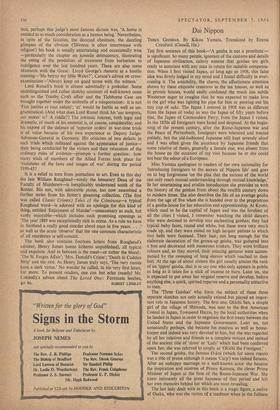Dai Nippon
THREE GEISHAS. By Kikou Yamata. Translated by Emma Craufurd. (Cassell, 16s.) THE first sentence of this book—`A geisha is not a prostitute'— is significant. So many people, ignorant of the customs and details of Japanese civilisation, calmly assume that geishas are girls ready to associate with any man in return for suitable compensa- tion. When I first visited Japan, as long ago as 1908, this false idea was firmly lodged in my mind and I found difficulty in over- coming it. The amiability, the charm, the affectionate attention shown by these exquisite creatures in the tea houses, as well as in private houses, would easily confound the much less subtle Westerner eager to imagine that he was expected to make love to the girl who was lighting his pipe for him or pouring out his tiny cup of sake. The Japan I entered in 1908 was as different from the Japan of today as was the Japan of fifty years before that, the Japan of Commodore Perry, from the Japan I visited. In the 1850s all foreigners were hated and despised. At the begin- ning of the present century, after the Russo-Japanese war and the Peace of Portsmbuth, foreigners were tolerated and treated politely, but the old-fashioned Japanese still kept severely aloof and I was often given the assurance by Japanese friends that some relative of theirs, generally a female one, was absent from the house on the occasion of my visit because he or she could not bear the odour of a European.
Miss Yamata apologises to readers of her own nationality for `introducing foreigners to the secrets of Nippon life' and goes on to beg forgiveness 'on the plea that the nations of the world can only reach mutual understanding through mutual knowledge.' In her entertaining and erudite introduction she provides us with the history of the geishas from about the twelfth century down to modern times. She also describes the life of an average geisha from the age of five when she is handed over to the proprietress of a geisha-house for her education and apprenticeship. At Kyoto, which used to be the capital of Japan and was the loveliest of all the cities I visited, I remember watching the child dancers who were destined to develop into enchanting geishas; they had typical baby faces, round and white, but these were very much made up, and they were raised on high lacquer pattens to which tiny bells were fastened. Their hair, not long enough for the elaborate decoration of the grown-up geisha, was gathered into a bun and decorated with numerous trinkets. They wore brilliant colours and, as they moved, their mincing gestures were accom- panied by the sweeping of long sleeves which reached to their feet. At the age of about sixteen the girl usually attains the rank of an 'ippon' geisha, that is to say one who only appears in public as long as it takes for a stick of incense to burn. Later on, she is expected to put away her virginal reserve and develop, before anything else, a quick, spirited repartee and a personality attractive to men.
The 'Three Geishas' who form the subject of these three separate sketches not only actually existed but played an impor- tant role in Japanese history. The first 'one, Okichi San, a simple girl of the village of Shimoda, was sent to the first American Consul in Japan, Townsend Harris, by the local authorities when he landed in Japan in order to negotiate the first treaty between the United States and the Japanese Government. Later on, not unnaturally perhaps, she became his mistress as well as house- keeper and indeed was very devoted to him, but she Was regarded by all her relatives and friends as a complete outcast and instead of the ancient title of 'dono' or 'Lady' which had been conferred upon her, she was referred to simply as 'Okichi the Foreigner.'
of her beauty and the heyday of her youth he chopped off both her arms. In spite of this fearful catastrophe this geisha carved out for herself bravely and wisely a new existence and lived to a fairly ripe old age.
I must congratulate Emma Craufurd on her translation, but wonder if she translated direct from Japanese or from some other European language in which the cosmopolitan authoress may well have written. The coloured reproduction of a geisha by Moronobu is by courtesy of the Museum of Eastern Art of



































 Previous page
Previous page